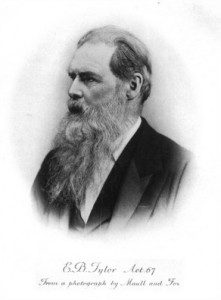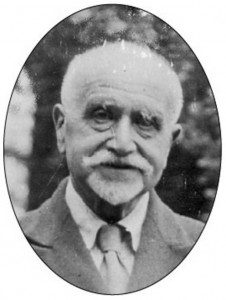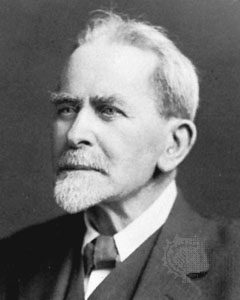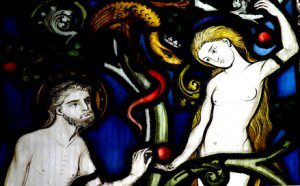Connor Wood
After a nice two-week break, I’m returning to my series of primers on theories of religion. This week we’re looking at three early anthropologists who believed that cultures evolve from “primitive” to “civilized” stages, and that religion is a characteristic of the earlier stages. Science and rationality (trumpet sounds!), of course, characterized the later, more advanced stages of development. Excelsior!
This post will have a lot of words like “primitive” and “savage” in it. I don’t use these words in my own work, so don’t get all huffy when you read them, all right? All right. I’m using the language of early anthropology to show the mindset and presuppositions these theorists brought to their work. At the same time, try not to dismiss everything they had to say automatically – their theories and ideas might be out of date (and, um, racist), but they helped advance the disciplines of anthropology and the study of religion, and many of their ideas are still influential today, even if they’re not accepted at face value.
E.B. Tylor

You know how everyone (read: science writers and evolutionary psychologists) assumes that today’s hunter-gatherer cultures are basically the same as our own pre-agricultural forebears? Edward Burnett Tylor (1832-1917) is largely the reason for this. Tylor spent his entire career investigating the notion that humans inevitably progress through evolutionary stages from primitive to civilized. For Tylor, religion is an outgrowth of primitive animism, or the belief in spiritual beings. What separates civilized peoples from primitive ones is that civilized folks have transitioned away from a worldview that’s dominated by invisible spiritual beings to one that looks instead for regular physical laws and scientific explanations.
Tylor’s theory of how primitive minds develop their beliefs in spiritual beings is one that parallels many of today’s cognitive-science hypotheses: according to Tylor, people notice that they seem to have experiences of wandering around in other realms while dreaming, and this experience leads naturally to the idea that we each have a ghost or spirit that can detach from the body. This observation leads to the conclusion that life is actually rooted in a spiritual essence rather than matter. As Tylor put it:
In the first place, what is it that makes the difference between a living body and a dead one; what causes waking, sleep, trance, disease, death? In the second place, what are those human shapes which appear in dreams and visions?
Tylor believed that primitive peoples accepted their own faulty reasoning about spirits because they were incapable of properly distinguishing between subjects and objects, or between imagination and reality. But this wasn’t because primitive people were fundamentally inferior to or different from civilized folks. Instead, Tylor argued that “mankind is homogenous in nature, though placed in different grades of civilization.” Because of Tylor’s claim that people have the same kinds of minds across cultures, late 19th-century enthographers and missionaries began to think of the rituals and myths of the peoples they studied as being religious, and therefore analogous (although inferior) to Christianity.
Although Tylor’s work sounds a bit outdated (read: bigoted) to us today, it fit very neatly within the philosophical landscape of the late 19th century. Tylor was deeply influenced by the French philosopher Auguste Comte, who argued tirelessly that human culture evolved through stages.* Many very smart 19th-century people believed that evolution was a teleological, or goal-directed, process, inevitably marching from chaos to order, from primitive to civilized. Tylor believed that religion was a vestige that survived in modern times in forms such as theology and mythology, but would eventually be supplanted by science and progress.
Lucien Lévy-Bruhl

Lucien Lévy-Bruhl (1857-1939) differed from his contemporary E.B. Tylor in several ways. First, he was French. Also, he possessed a much less impressive beard. But most importantly, Lévy-Bruhl did not believe, as Tylor did, that civilized and primitive peoples had basically the same sort of minds, just at different levels of development. On the contrary; for Lévy-Bruhl, there was a nearly impassable gap between the thought processes of civilized and uncivilized peoples, and he used this gap to explain religion.
Like Tylor, Lévy-Bruhl was influenced by Auguste Comte’s ideas about the evolution of culture, and assumed that human societies evolved teleologically through stages. But the distinctions between the cognitive habits of the early and later stages were stark indeed. For Lévy-Bruhl, what most distinguished the civilized from the primitive mentality was Aristotle’s Law of Noncontradiction, which asserts that nothing can both be true and false at the same time. (For instance, the sentence “I am in Reno and I am also in Denver” would be a violation of the Principle of Noncontradiction, because the speaker is claiming to both be in Reno and to not be in Reno simultaneously.†) This law is one of the most important logical foundations of Western thought. And Lévy-Bruhl claimed that primitives simply do not abide by it.
Instead, Lévy-Bruhl argued, primitive minds adhere to a Law of Participation, which allows them to believe that every object or entity in the world is somehow both itself and something else – something more mystical. For example, Lévy-Bruhl noted that many tribal cultures have totemic rituals, in which members of distinct groups or clans literally believe themselves to be certain kinds of animals, or to somehow participate in the animalness of their totemic beasts. In a given tribe, for instance, there might be a Bear clan and an Eagle clan and a Badger clan. Lévy-Bruhl argued that these identities are not metaphorical or poetic; instead, members of the Badger clan literally believe that they are somehow badgers. But of course they are also humans. And so voilà: the Law of Noncontradiction is violated without even a raised eyebrow. From this violation – and not from Tylor’s animistic beliefs – arises the mystical thinking and belief in invisible forces that underlie religion.
James Frazer

James G. Frazer (1854-1941), author of the anthropological classic The Golden Bough, was – and still is – the most widely influential of the three Dead White Men we’re covering today. He didn’t just give a kick-start to social anthropology and comparative ethnology; he also stamped his influence on the literature and popular culture of the 20th century, shaping the work of writers as diverse as James Joyce, Joseph Campbell, and T.S. Eliot. By attempting to show how mythology and religious ideas exhibited common patterns worldwide, he advanced the notion that civilized Europeans weren’t so different from “savages” after all, and that religions like Christianity were just unique manifestations of cross-cultural motifs – an idea that’s still popular today, especially among laypersons (and neo-Pagans).
But Frazer’s ideas about universal mythological motifs did not mean for a second that he thought primitive and civilized societies were equal. Nuh-uh. Like Tylor and Lévy-Bruhl, Frazer thought that human societies moved through evolutionary stages. Specifically, Frazer famously argued that societies moved through magic to religion and then finally on to science. Although he believed that science was the most advanced of the three stages, he was most interested in the stage he called “magic.”
For Frazer, magical thought – the most primitive stage of cultural development – is defined by the belief that the world operates according to fixed laws, and that humans can manipulate these laws to get what they want. In this sense, magic is exactly like science, right? Except that magic operates by mistaken logic and faulty assumptions – most especially, the assumption that the laws governing how things work in the world are reflections of what goes on in our minds. Specifically, Frazer famously claimed that magic was powered the Law of Similarity and the Law of Contact or Contagion. The Law of Similarity dictated that things that are similar to one another influence one another – for example, ancient Greeks ate the eggs of ravens (which are black) in order to turn their hair black. The Law of Contact stipulated that, once two things had been in contact with each other, they would continue to affect one another even after being separated. An example might be the classic idea that a bit of hair from someone’s body is still somehow mystically connected with that person.
Magic gave way to religion, Frazer believed, once people realized that their magical reasoning wasn’t getting them anywhere. In the religious stage of human development, people no longer believed that the universe operates according to strict laws; instead, they saw it as being under the influence of capricious, supernatural agents. Religion, for Frazer, was “a propitiation or conciliation of powers superior to man which are believed to direct and control the course of nature and of human life.” In other words, religion was what happened once people decided the universe was a crazy place governed by irascible, unpredictable spirits and gods instead of neat, impersonal, magical rules.
After religion came science, which returned to the magical view that the world is actually governed by fixed, discoverable laws – but this time with experimental and logical rigor, leading to the discovery of the correct laws. But Frazer believed that science might not even be the final stage, writing that
…as science has supplanted its predecessors, so it may hereafter be itself superseded by some more perfect hypothesis, perhaps by some totally different way of looking at the phenomena–of registering the shadows on the screen—of which we in this generation can form no idea.
_____
* …And eventually alienated everyone he knew by being the world’s biggest curmudgeon, but that’s another story.
† Warning: if you find yourself to both be in Reno and not be in Reno simultaneously, you may be on a drug bender












